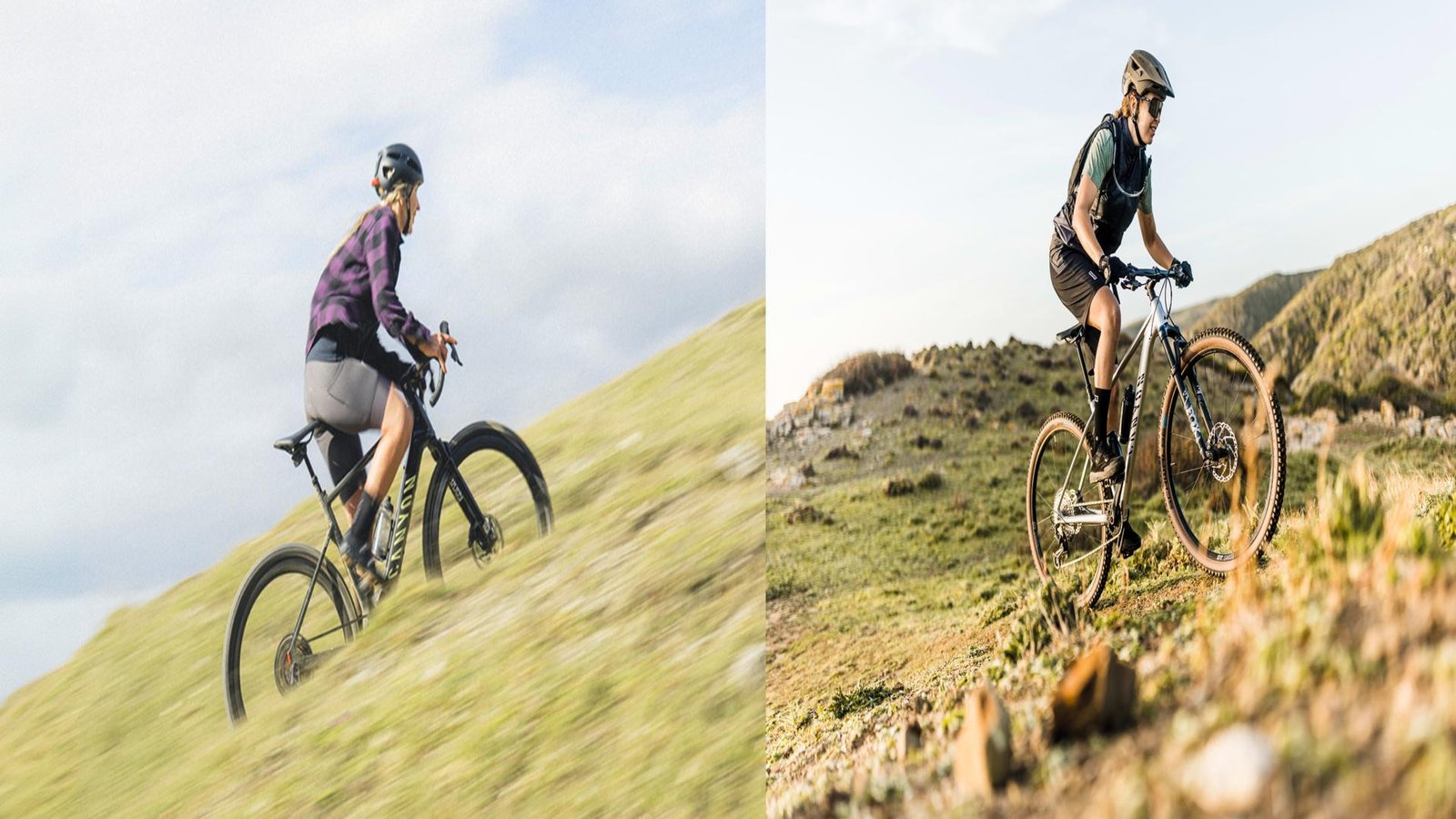When you stand at the crossroads of choosing between a mountain bike and a road bike, the decision can feel overwhelming. Each bike has its own unique features and purposes, catering to different styles of riding and terrains.
But how do you know which one is right for you? Understanding the key differences between these two types of bicycles can help you make an informed choice that aligns perfectly with your cycling needs. Imagine conquering rugged trails with ease or gliding smoothly on paved roads—choosing the right bike can transform your riding experience.
Stick around as we dive into the distinct characteristics of mountain bikes and road bikes, helping you discover which one will best fuel your passion for cycling.
Bike Frame Design
Bike frames hold all parts of the bike together. They affect how the bike rides and handles.
Mountain bikes and road bikes have different frame designs. These differences fit their riding styles.
Mountain Bike Frames
Mountain bike frames are strong and built to handle rough trails. They use thick tubing for extra durability.
The design allows more space for wide tires and suspension parts. This helps absorb shocks from bumps and rocks.
- Sturdy and heavy frame
- Sloped top tube for better control
- Room for wide, knobby tires
- Built to support suspension systems
Road Bike Frames
Road bike frames are light and designed for speed on smooth pavement. They use thinner tubing to reduce weight.
The shape is aerodynamic, with a higher top tube. This helps the rider lean forward for less wind resistance.
- Lightweight and sleek frame
- Horizontal or slightly sloped top tube
- Fits narrow, smooth tires
- Focus on speed and efficiency
Tire Type And Size
Tire type and size affect bike performance and comfort. Mountain bikes and road bikes use different tires for different surfaces.
Understanding these differences helps you choose the right bike for your riding style and terrain.
Mountain Bike Tires
Mountain bike tires are wide and knobby. They provide grip on rough and loose surfaces like dirt and rocks.
- Width: Typically 2.1 to 2.5 inches wide
- Tread: Deep and aggressive for traction
- Size: Commonly 26″, 27.5″, or 29″ diameter
- Pressure: Lower pressure to absorb shocks
Road Bike Tires
Road bike tires are narrow and smooth. They reduce rolling resistance on pavement for faster speed.
| Feature | Typical Range | Description |
|---|---|---|
| Width | 23 mm to 32 mm | Narrow for less drag and quicker acceleration |
| Tread | Smooth or minimal patterns | Designed for hard, flat surfaces |
| Size | 700c diameter | Standard road bike wheel size |
| Pressure | Higher pressure (80-130 psi) | Reduces rolling resistance |
Handlebars And Riding Position
The handlebars and riding position on mountain bikes and road bikes are quite different. These differences affect control, comfort, and riding style.
Understanding these differences helps riders choose the right bike for their needs and riding habits.
Mountain Bike Handlebars
Mountain bikes have flat or riser handlebars. These bars are wide to give better control on rough trails. The riding position is more upright to help balance and reduce strain.
- Wide grip for stability on uneven terrain
- Flat or slightly curved bars for easy handling
- Higher position to keep the rider upright
- Better control when standing or moving over obstacles
Road Bike Handlebars
Road bikes use drop handlebars. These bars curve down and allow multiple hand positions. The riding position is lower and more aerodynamic to increase speed.
| Feature | Benefit |
| Drop shape | Allows different grips for comfort and speed |
| Lower position | Reduces wind resistance for faster riding |
| Narrow width | Improves aerodynamics and efficiency |
| Multiple hand positions | Helps reduce fatigue on long rides |

Suspension Systems
Suspension systems affect how a bike feels and performs on different surfaces. They help absorb bumps and shocks.
Mountain bikes and road bikes use very different suspension designs. These differences suit their riding styles.
Full Suspension
Full suspension bikes have shock absorbers on both wheels. This setup improves comfort on rough trails.
- Front suspension fork absorbs bumps on the front wheel.
- Rear suspension system smooths out shocks on the back wheel.
- Better control on uneven terrain and downhill rides.
- Usually heavier and needs more maintenance.
Rigid Frames
Rigid frames do not have any suspension parts. They are common on road bikes and some mountain bikes for smooth trails.
| Bike Type | Suspension | Weight | Maintenance |
| Mountain Bike (Full Suspension) | Front and rear shocks | Heavier | Higher |
| Road Bike (Rigid Frame) | No suspension | Lighter | Lower |
Gear And Braking Systems
Mountain bikes and road bikes use different gears and brakes. These parts fit their riding styles and terrains.
Understanding these differences helps you choose the right bike for your needs.
Mountain Bike Gears And Brakes
Mountain bikes have many gears to handle steep hills and rough trails. They use wide gear ranges for better control.
Mountain bikes often use disc brakes. These brakes work well in mud, rain, and dirt.
- Gears: 10 to 12 speeds, with a wide range
- Brakes: Hydraulic or mechanical disc brakes
- Gears help climb steep and rocky paths
- Disc brakes give strong stopping power in tough conditions
Road Bike Gears And Brakes
Road bikes have tighter gear ranges. They focus on speed and smooth pedaling on paved roads.
Road bikes mostly use rim brakes or disc brakes. Rim brakes are lighter but less effective in wet weather.
- Gears: Usually 18 to 22 speeds with close ratios
- Brakes: Rim brakes or hydraulic disc brakes
- Gears optimize speed and cadence on flat roads
- Rim brakes are lightweight but less good in rain
- Disc brakes offer better stopping power in all conditions
Weight And Durability
Mountain bikes and road bikes differ a lot in weight and durability. These differences affect how they perform on different surfaces.
Knowing these differences helps you pick the right bike for your riding style.
Mountain Bike Weight
Mountain bikes are usually heavier than road bikes. They need strong parts to handle rough trails and rocks.
The extra weight comes from thicker frames and wider tires. This makes the bike tougher but slower on smooth roads.
- Heavy frame for strength
- Wide tires for better grip
- Strong suspension to absorb shocks
Road Bike Weight
Road bikes are lighter to help riders go faster on pavement. They use thin frames made from light materials like carbon or aluminum.
Lightweight parts and narrow tires reduce weight and rolling resistance. This makes road bikes less durable on rough surfaces.
- Thin, light frame
- Narrow tires for speed
- Less shock absorption
Terrain Suitability
Mountain bikes and road bikes are built for different terrains. Each bike type handles surfaces in unique ways. Choosing the right bike depends on where you plan to ride most.
This guide explains how mountain and road bikes suit off-road and paved road riding. Understanding this helps you pick the best bike for your adventures.
Off-road Riding
Mountain bikes are designed for rough trails and uneven ground. Their features make off-road riding easier and safer.
- Wide, knobby tires provide better grip on dirt and rocks.
- Strong suspension systems absorb shocks from bumps and roots.
- Durable frames handle impacts and rough use.
- Lower gear options help climb steep hills on trails.
Paved Road Riding
Road bikes suit smooth, paved surfaces like city streets and highways. They focus on speed and efficiency over comfort on rough terrain.
| Feature | Mountain Bike | Road Bike |
| Tires | Wide and knobby for traction | Narrow and smooth for less resistance |
| Frame | Sturdy and shock-absorbing | Lightweight and aerodynamic |
| Suspension | Front or full suspension | Usually none |
| Gears | Lower gears for climbing | Higher gears for speed |

Comfort And Performance
Mountain bikes and road bikes serve different riding needs. Comfort and performance set them apart.
This guide explains how each bike type focuses on these two aspects.
Mountain Bike Comfort
Mountain bikes offer a comfortable ride on rough trails. Their design reduces strain on the rider.
- Wide, knobby tires absorb shocks from rocks and roots
- Suspension systems cushion bumps and drops
- Upright riding position eases back and neck pressure
- Wide handlebars provide better control and stability
- Sturdy frames handle uneven terrain without damage
Road Bike Speed
Road bikes focus on speed and efficiency on smooth surfaces. They have features that reduce drag and weight.
| Feature | Benefit |
| Narrow tires | Lower rolling resistance for faster rides |
| Lightweight frame | Easier to accelerate and climb hills |
| Drop handlebars | Allows aerodynamic riding positions |
| Slick tire tread | Improves grip on pavement without added drag |
| High gear ratios | Supports higher speeds on flat roads |
Cost And Maintenance
Mountain bikes and road bikes serve different purposes. Their price and maintenance reflect these differences. Understanding these factors helps you choose the right bike.
This section explains how cost and upkeep vary between the two bike types.
Price Differences
Mountain bikes usually cost more upfront. They need stronger parts to handle rough trails. Road bikes focus on speed and light weight, which can also raise prices.
| Bike Type | Price Range | Key Cost Factors |
| Mountain Bike | $500 – $5000 | Suspension, strong frame, wider tires |
| Road Bike | $400 – $7000 | Lightweight frame, thin tires, aerodynamic design |
Maintenance Needs
Mountain bikes need more frequent maintenance. Dirt and mud affect brakes and gears. Road bikes require less frequent tuning but need careful tire care.
- Mountain bikes need regular cleaning after rides.
- Suspension parts require occasional servicing.
- Road bikes need tire pressure checks before each ride.
- Brake pads wear differently on both bike types.
- Both need chain lubrication to work smoothly.

Choosing The Right Bike
Choosing between a mountain bike and a road bike depends on your needs. Both bikes serve different purposes and fit different riding styles.
Knowing the difference helps you pick the best bike for your rides and comfort.
Assessing Your Riding Style
Think about where you will ride most often. Mountain bikes work best on rough trails and dirt paths.
Road bikes are designed for smooth pavement and fast riding. Your choice depends on the terrain you prefer.
- Mountain bike: good for off-road, steep climbs, and rough surfaces
- Road bike: ideal for flat roads, speed, and long distances
- Consider how often you ride on each terrain
Budget Considerations
Bikes come in many price ranges. Mountain bikes often cost more because of their strong parts and suspension.
Road bikes can be cheaper or expensive depending on materials and features. Set a budget before buying.
- Decide how much you want to spend
- Check prices for basic and advanced models
- Remember to include gear like helmets and gloves
Frequently Asked Questions
What Are The Main Differences Between Mountain And Road Bikes?
Mountain bikes have wider tires, stronger frames, and suspension for rough terrains. Road bikes feature thinner tires, lightweight frames, and smooth designs for speed on pavement.
Which Bike Is Better For Off-road Trails?
Mountain bikes are better for off-road trails due to their durable tires and suspension. They provide better control and comfort on uneven surfaces.
Can I Use A Road Bike For City Commuting?
Yes, but road bikes excel on smooth roads. They offer speed and efficiency but may struggle on rough or uneven city streets.
How Do Mountain And Road Bike Tires Differ?
Mountain bike tires are wide with deep treads for grip on dirt. Road bike tires are narrow and smooth for less rolling resistance on pavement.
Conclusion
Mountain bikes and road bikes serve different riding styles. Mountain bikes handle rough trails and uneven paths well. Road bikes are built for speed on smooth roads. Choosing depends on where you plan to ride most. Comfort, terrain, and riding goals matter a lot.
Both types offer fun and exercise in their way. Now, you can pick the bike that fits your needs best. Enjoy your ride, whichever bike you choose!


